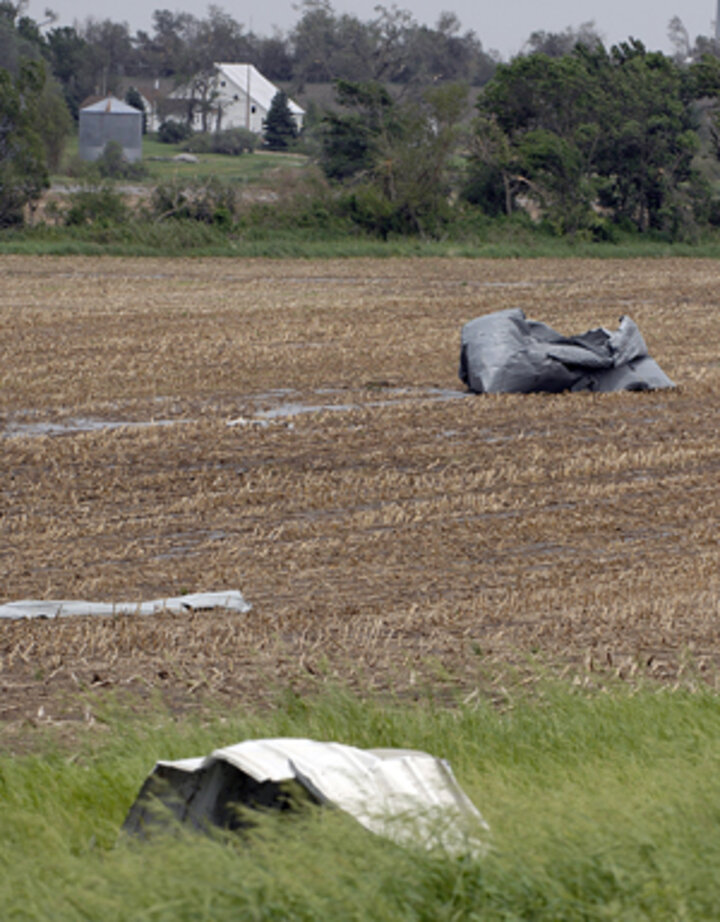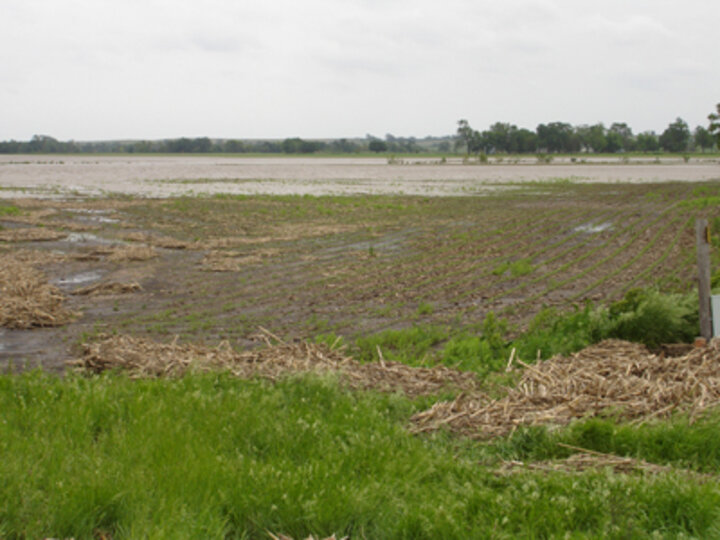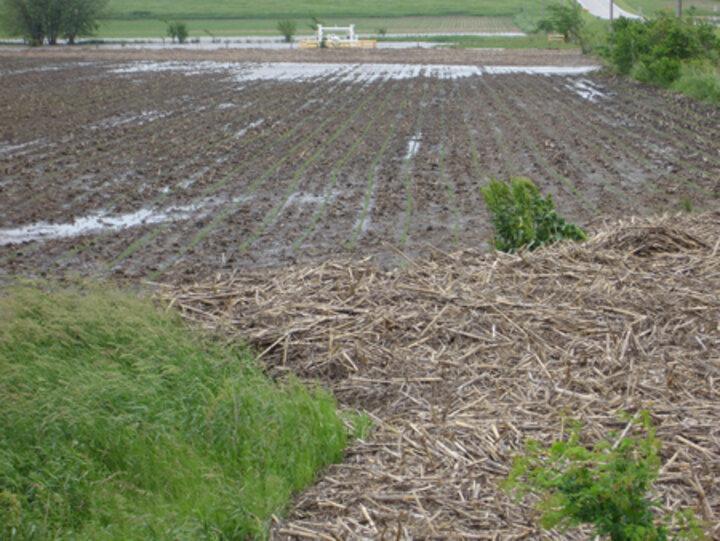June 6, 2008

|
| Grain bins torn apart and dropped in a nearby field near Ceresco in Saunders County. (IANR Photo by Brett Hampton) |
Keith Glewen, Extension Educator in Saunders County: Crops and buildings on farmsteads in the southern tier of townships in Saunders County from Valparaiso to Ashland received extensive storm damage in the last week. Hail, wind, and water damage is prevalent throughout the area. Many acres associated with creeks and streams were flooded or covered with silt and crop residue. Heavy rains in upland areas of the county caused significant erosion damage in some cases. Many growers have their first planting of soybeans to complete. Post-emergence herbicide application in corn is a challenge due to wet soil conditions. In short, the county looks like a war zone.
Karen DeBoer, Extension Educator in Cheyenne County: We have received some much needed moisture over the past several days. There has been isolated crop injury due to hail. We have seen isolated cases of wheat streak mosaic virus. Farmers are trying to plant summer crops like millet, but progress has been slowed due to rain.
Keith J. Jarvi, IPM Extension Assistant, Northeast REC, Norfolk: A tour through Northern Wayne and southern Dixon counties found conditions wet but they could be a lot worse. Heavy rain has been so localized it's hard to tell how individual fields have been affected. There is some standing water in low spots but it's hasn't been too bad. Rains have been spaced apart and lighter than in some other areas of the state. That being said, there has been enough rain the last 10 days or so that little field activity has been done and spraying for weeds is behind schedule. We are seeing a lot of bean leaf beetle activity in seedling soybeans, but so far it hasn't been at treatable levels.
David Stenberg, Extension Educator in Dawson County: We have had little field activity in the Lexington area for three weeks due to rain. In the Gothenburg area producers may have gotten in two to three days of field work over the last 20 days. Most of the crop was planted prior to the 10-11 inch rain we got 15 days ago. The frequency of a rain of this size in our rainfall area is once in every 1,000-2,000 years. Some fields stood in water for several days; however even now that the water has moved off the fields, they are still too wet to replant corn or soybeans or to finish planting soybeans. I have heard reports from a few farmers that they need to replant up to 25% of their corn when field conditions allow, if it is not too late. The problem is that much of the damage is on the lower end of the field. We have had some hail damage as well as some high wind damage to trees and buildings. Alfalfa harvest has been slow to non-existant due to wet conditions. The planted crops that were not impacted by standing water are doing fairly well and would really grow with some heat units. Because of the heavy rains, there is concern that some nitrogen may have been moved below the root zone.

|

|
| With the recent heavy rains, there has been considerable runoff and lowland flooding. When water gets deep enough to float residue, it will move with the water if it has been cut loose from the soil. Anchored and attached residue in true no-till stays put in the field. Residue cut loose by attachments on the planter, stalk chopping, harrowing, light tillage, or other similar operations will move with runoff. Residue that stays in the field reduces raindrop impact, reducing soil erosion. Though it looks bad, it's far easier to clean residue out of the road ditch than it is to clean out sediment washed in from tilled fields. Sediment from tilled fields plugs culverts, while residue floats on the water, allowing water to flow through the culvert.(Photos by Paul Jasa) |
Alan Corr, Extension Water Educator, West Central REC, North Platte: One of our demonstration sites in the north central part of Kearney County was destroyed by hail Wednesday night. Hail damage caused 100% loss in a fairly large area there and 5-25% loss in a much larger area of the county.
Jim Schneider, UNL Extension Educator in Hamilton County: Hamilton County suffered damage from a tornado and high winds on May 29. The tornado started west of Aurora and tracked in an arc around the south side of town and continued to cause damage east of Aurora where it turned over numerous rail cars. Several farms and homes were lost and approximately 135 pivots sustained damage. We estimate that 50 sections of land were in the path and that about 30% these might be candidates for replanting. Soybeans were pretty much wiped out just due to the wind (not hail). Corn is questionable as it ranged from V4 to V6 stage with the growing point near the soil surface. It's too wet to get in the fields now so time will tell on the corn.
On June 4 we had a storm that dumped 5 to 7 inches of rain along with large hail near the Marquette area. From this and previous rains 4,000 to 5,000 acres were under water by June 5. It is uncertain whether this submerged area will increase or decrease in size as water continues to move. There may be 500 to 1000 acres of beans to re-plant in this area due to hail. It's still too early to estimate the level of corn damage but I would estimate about 500 acres were affected. Another storm over Aurora Thursday night (June 5) dumped an inch of rain from a smaller more isolated cell.
Gary Lesoing, Extension Educator in Nemaha County: We've seen a significant amount of flooding in Nemaha and surrounding counties this week. Flood waters are receding some on the Little Nemaha River, but Missouri River bottoms are still being affected by high Missouri River levels caused by heavy rains upstream. Farmers will need to wait and see how much damage the flood waters have done to existing fields and then determine their strategies for replanting. Drier conditions earlier in the week allowed some soybeans to be planted, although there still are significant acres that need to be planted. Some fields are getting pretty weedy. Wheat is not looking too bad; some producers have sprayed with fungicide. Very little alfalfa in the area has been harvested.
William Booker, Extension Educator in Box Butte County: Recent rains have brought our total rainfall numbers close to average. Many producers reported getting two inches or more of rain over the last two weeks. This has changed lots of attitudes, but has brought some challenges too. Hail storms have producers looking at alternative crops that would fit into their cropping systems. They are looking at millet and sunflower in failed wheat, for example. Forage crops would work too. Hail at this stage makes one look at alternative crops. Pastures are greening up and should have some reserve, although the long-term drought condition has not improved. It will take years to get the pastures back to pre-drought condition. As they recover, it will be imporant to not overgraze them.
Tom Dorn, Extension Educator in Lancaster County: On Thursday, June 5, in northern Lancaster County, I saw alfalfa fields that had not been cut damaged by hail and tangled into clumps by wind. While driving the Ashland road from 14th Street to Highway 77, there was extensive tree breakage, four houses were damaged, all with garages and machine sheds badly damaged or destroyed. Debris was scattered in fields. Power lines were down. Water was still crossing the road in several spots. Fields were flooded and crops were washed out in places. Terraces were full and some had over-topped. In southern Lancaster County terraces were full and small streams had gone out of their banks in numerous places. Windrowed hay was washed off the hillsides. Water was standing in every fairly level field and lower areas of every sloping field was or had been flooded. Salt Creek south of Lincoln was out of its banks on Thursday and remained out on Friday.
